King of the Med: Exclusive Interview with Chef Gérald Passédat
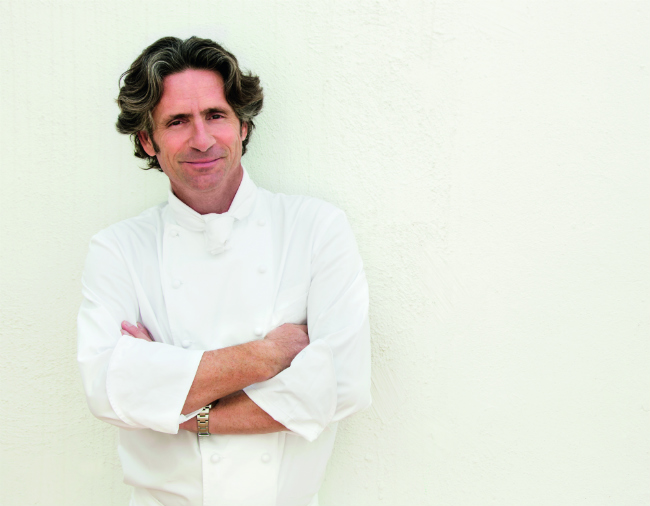
Gérald Passédat is the legendary three Michelin-star chef and owner of Le Petit Nice in Marseille, the city of his birth. He is a passionate champion of seafood cuisine, which also draws upon the many vegetables and herbs found in Provence. To coincide with the launch of his inspirational new cookbook, Flavours from the French Mediterranean, Justin Postlethwaite caught up with Gérald for an exclusive chat about his influences, his passion for the region and much more…
France Today: What is your earliest food memory, and your favourite dishes from childhood?
Gérald Passédat: As a child, my favourite dish was little stuffed vegetables. When I was 12 years old, my parents took me for a meal at chef Alain Chapel’s restaurant. It was a life-changing experience for me and a taste revelation. I can still vividly recall the flavour of the crayfish Sauternes sauce. I knew then that I wanted to become a chef and that one day I would have three stars.
FT: How did your childhood, with many chefs in the family, influence your love and passion for cooking?
GP: I remember the Sunday lunches we used to have at my Aunt Nia and Uncle Jesus’s house when I was a child – the magnificent fish dishes and their pan drippings that I savoured. A wonderful memory.
FT: Your new cookbook contains recipes passed down from previous generations of your family. How important to you is maintaining tradition and passing on knowledge to new generations?
GP: Thanks to food lovers sharing and transmitting their knowledge, the secrets of traditional Mediterranean cuisine have been passed down to our generation. It is up to us to perpetuate this culinary tradition of simple, popular dishes. Every cook possesses a particular skill, a certain proficiency that it is his duty to recreate and enhance with his own personal touch. History can often be an important source of creativity.
FT: You have enjoyed a long and prestigious career at the very top of the culinary world. What skills and personality traits does it take to be an enduringly successful 3-star Michelin chef?
GP: Humility, selflessness and a desire to share.
FT: If you had been born in Lille or Rennes, your cooking style and ingredient choices would undoubtedly be different. How has the south, especially Marseille, influenced who you are, firstly as a Frenchman, and secondly as a chef?
GP: For me, it is vital for any chef to convey his personal vision of his region. Cuisine should advocate a culture of responsible behavior, as well as the choice of our producers, taking into account organic farming and sustainable fishing.
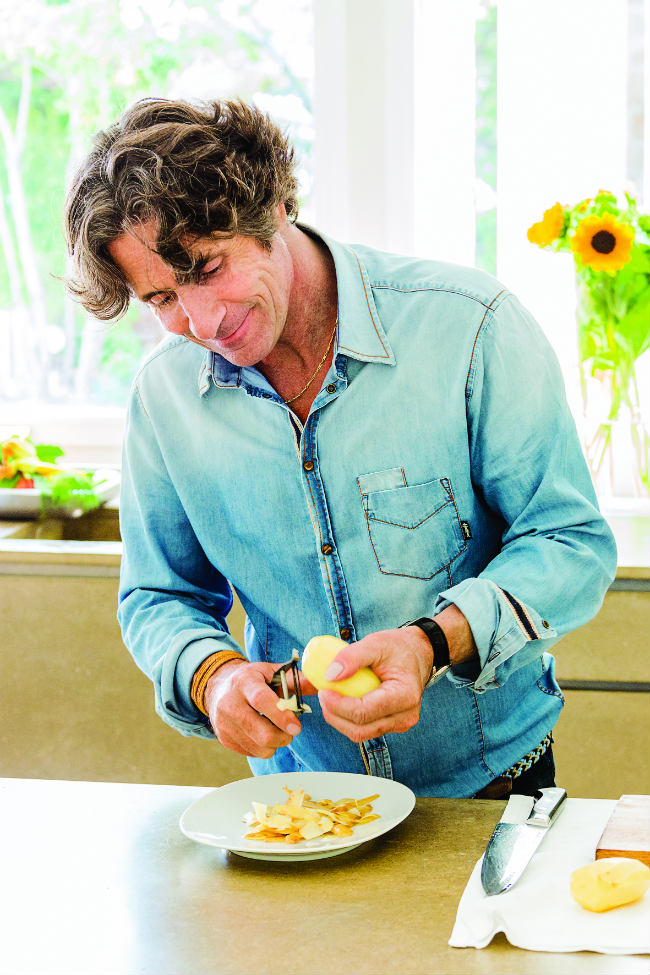
Chef Gérald Passédat. Photo: Richard Haughton, Flammarion 2016
FT: You clearly adore the sea. What makes seafood so special to you?
GP: The taste of sea salt – a unique flavour in the Mediterranean.
FT: Describe your relationship with the fishermen of Marseille.
GP: I’ve been building close relationships with my fishermen for almost 20 years. They fish for my restaurant, Le Petit Nice, using traditional methods, based on seasonality in order to respect the different species of fish. Every day, they deliver their catch straight to Le Petit Nice without the use of ice, which burns the flesh.
FT: What is your favourite fish to eat?
GP: Mullet.
FT: I’ve never eaten sea anemone, one of your speciality dishes. What am I missing?
GP: It has a much more refined flavour than sea violets (sea figs) and is less sweet than sea urchins. The taste is somewhere between that of an oyster and a small squid. I like to cook these sea flowers in a variety of ways, creating creamy, fresh, or crispy versions, drawing inspiration from the recipes of fishermen’s wives and grandmothers from Marseille.
FT: Who makes the best bouillabaisse (apart from you, of course!)?
GP: The restaurant Chez Michel.
FT: What are the five most important ingredients at a chef’s disposal?
GP: Olive oil, of course! Vegetables are also indispensable, with a strong preference for tomatoes, bay leaves, and sage, not to mention fish, my Mediterranean treasures. Over the course of one year, I cook with more than 65 different species of fish at Le Petit Nice.
FT: A recent survey revealed that the most popular dish in restaurants in France is le burger. What do you make of this news?
GP: My vote goes to fish and chips.
FT: I’m coming round to yours for dinner (thanks for the invite!). What dish would you cook for me that sums up your culinary ethos?
GP: Lucie Passédat sea bass, a recipe from my restaurant.
FT: Imagine that all the wine in the world will suddenly, horrifyingly, disappear tomorrow – but that you can choose one bottle to savor. What would it be?
GP: A bottle of Romanée-Conti.
FT: And finally, you are granted a wish to change gastronomic life in France. What would it be?
GP: Simply, to take pleasure in sharing. More information at www.passedat.fr/en
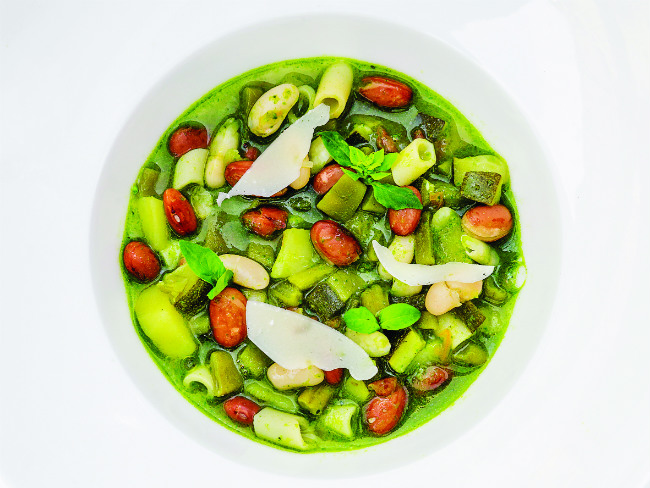
Pistou soup. Photo: Richard Haughton, Flammarion 2016
As seen in Gérald Passédat’s new cookbook, Flavours from the French Mediterranean:
Grandfather Barthélemy’s Pistou Soup (Soupe au Pistou Barthélemy)
Serves 4 | Preparation time: 1 hour 30 minutes | Soaking time: 12 hours | Cooking time: 50 minutes
Ingredients
1/2 cup (3 1/2oz./100 g) dried borlotti beans
2 potatoes
2 zucchini (courgettes)
3 1/2 oz. (100 g) green beans
3 1/2 oz. (100 g) flat green beans
2 plum tomatoes
1/2 cup (3 1/2 oz./100 g) navy (haricot) beans (preferably coco)
1 1/4 cups (5 oz./150 g) elbow pasta (macaroni) or other small pasta shapes
Salt, pepper
For the pistou
3 cloves garlic
1 small bunch basil
1/4 cup (1 1/2 oz./40 g) grated Parmesan
3 1/2 tablespoons (1oz./30 g) pine nuts
Scant 1/2 cup (100 ml) Passédat olive oil
1. Soak the borlotti beans in cold water for 12 hours before making the soup.
2. Wash all the vegetables. Peel the potatoes and cut them into approximately 1/2 in. (1 cm) cubes. Cut the zucchini into cubes of the same size. Cut the green beans and flat beans into lengths of approximately 1/2 in. (1 cm). reserve the prepared vegetables.
3. Remove the stalks from the tomatoes and cut a cross in the base of each one with a small knife to make them easier to peel.
4. Immerse in boiling water for a few seconds, then in cold water and slip off the skins. Quarter the tomatoes, remove the cores, and scoop out the pulp. Chop the tomato flesh into small cubes and reserve.
5. Drain the borlotti beans and put in a large pan of cold water with the navy beans. Place on the heat and cook for 20 minutes. Add the potatoes, zucchini, green beans, and flat beans and let cook for an additional 20 minutes. Add the pasta and cook for an additional 10 minutes.
6. Make the pistou. Peel the garlic, remove the stalks from the basil, and put the leaves in a mortar with the garlic, Parmesan, and pine nuts. Grind with the pestle, gradually adding the olive oil until you have a smooth, thick pistou sauce. Season with salt and pepper to taste.
7. Take the soup off the heat and add the pistou, check the seasoning, and serve hot.
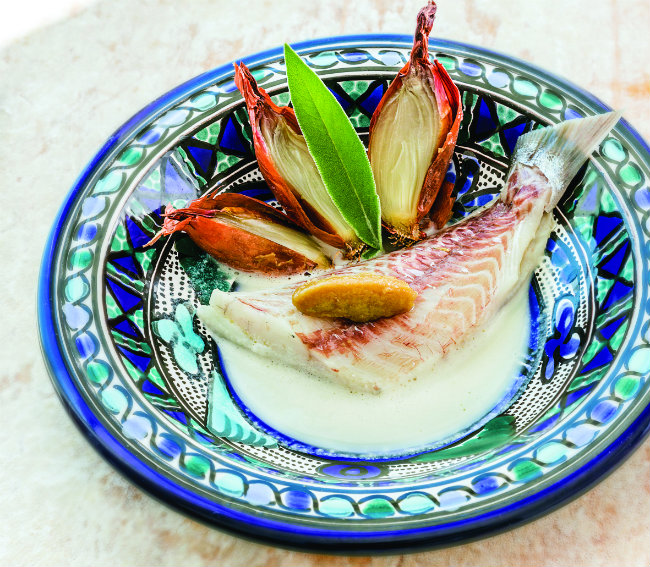
Sea bream. Photo: Chef Gérald Passédat. Photo: Richard Haughton, Flammarion 2016
Sea Bream in a Garlic Bouillon (Aïgo Boulido)
Serves 4 | Preparation time: 2 hours | Cooking time: 2 hours 15 minutes
Ingredients
4 small sea bream, weighing 12 oz. (350 g) each
3 heads garlic
6 shallots
2 cups (1 lb. 2 oz./500 g) kosher salt
2 cups (500 ml) fish stock
5 oz. (150 g) any white fish fillets
Scant 1/4 cup (50 ml) whipping cream
6 sage leaves
Salt, pepper
1. Preheat the oven to 300 degrees F (150 degrees C/Gas mark 2).
2. Put two of the heads of garlic and all the shallots between two layers of kosher salt in an ovenproof dish and cook in the oven for 1 hour 30 minutes. When cooked, cut the shallots in half lengthways and squeeze the soft garlic from the heads. Set aside.
3. Reduce the oven temperature to 250 degrees F (130 degrees C/Gas mark 1/2).
4. Clean and scale the four sea bream. Remove the two fillets from each fish by slicing lengthways along the backbone on either side, but leaving the fillets attached at the belly. Clean the fish, remove the bones and skin, and lay them side by side in an ovenproof dish. Season, pour over 1 cup (250 ml) of the stock, and cook in the oven for 15 minutes.
5. Remove any bones or pieces of skin from the white fish fillets, put the remaining stock in a saucepan, and add the fillets. Separate the third head of garlic into cloves, peel them, and add to the saucepan. Cook for 30 minutes. remove the saucepan from the heat, add the cream and two sage leaves, and allow to infuse for a few minutes. remove and discard the sage leaves. Pour this bouillon into a liquidizer and blend until smooth. Add salt and pepper to taste.
6. Pour a little bouillon into each plate and lay a sea bream fillet in the center. Arrange three shallot halves and a sage leaf around it, then place a quenelle-shaped teaspoonful of the reserved garlic puree on top.
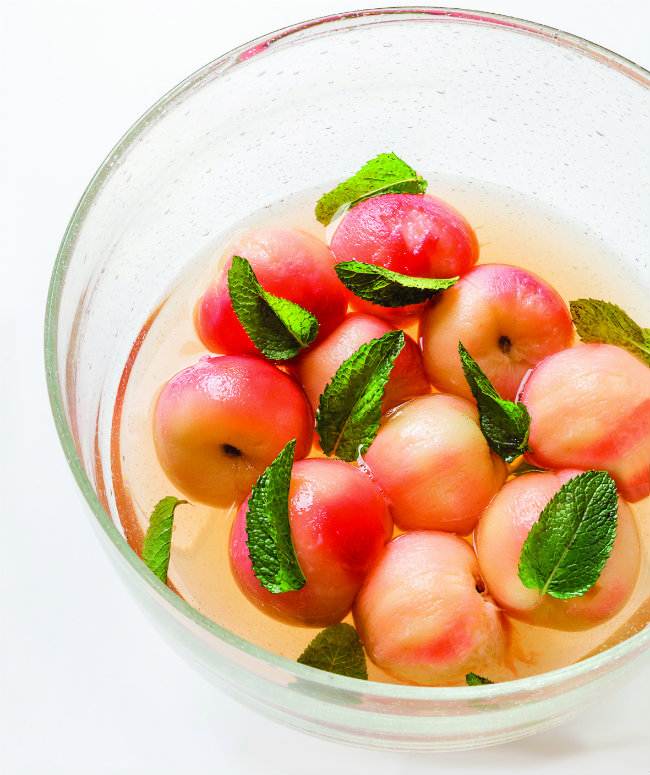
Poached peaches. Chef Gérald Passédat. Photo: Richard Haughton, Flammarion 2016
Vine Peaches Poached in Green Tea Syrup with Mint (Pêches de vine au Thé Vert et a la Menthe)
Serves 4 | Preparation time: 35 minutes | Cooking time: 10 minutes | Infusing time: 10 minutes
Ingredients
2 cups (500 ml) water
1/3 cup (2 oz./60 g) sugar
8 peaches
1 tablespoon green tea leaves
10 mint leaves
1. Heat the water and sugar in a deep pan until the sugar dissolves.
2. Bring to a boil, add the whole peaches, and allow them to poach over a low heat for 10 minutes. lift them out with a slotted spoon and reserve.
3. Add the green tea leaves to the syrup while the syrup is still hot, remove from the heat, and allow to infuse for 10 minutes.
4. Strain the syrup, discarding the tea leaves. Pour the syrup into a large serving bowl and add the mint leaves. Slip the skins off the peaches and add them to the syrup. Chill in the refrigerator until ready to serve.
Excerpts from “Flavours from the French Mediterranean”, published by Flammarion, as seen in France Today magazine
Share to: Facebook Twitter LinkedIn Email
Leave a reply
Your email address will not be published. Required fields are marked *



